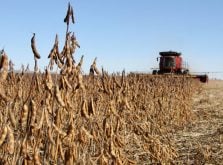Fuelled by a 28 percent increase in grain revenue, Canadian Pacific Railway recorded a huge improvement to its bottom line in the first quarter of 2006.
The rail company last week announced that net income during the three months ending March 31 totalled $111 million, up 38 percent from $81 million in the same period last year.
Diluted earnings per share for the quarter increased by 40 percent to 74 cents from 53 cents.
The announcement continues the trend of the past year of skyrocketing railway profits, a trend that has led grain shippers and farmers to complain that rail companies, particularly Canadian National Railway, are padding their bottom lines at the expense of service.
Read Also

Manitoba extends Crown land rent freeze
Manitoba government links the continued rental rate freeze on grazing and forage leases to economic and environmental challenges facing the industry
However, CPR chief executive officer Rob Ritchie says increased fluidity, which refers to increased train speed and reduced downtime, is benefiting everyone.
“With increased fluidity, we are driving more value from our assets, delivering a better product to our customers, which in turn is producing better results for our shareholders,” he said in a News release
news.
CPR says its average train speed is up 17 percent from last year, processing time in rail yards is down 32 percent and car velocity, which is the distance that a rail car travels in a day, is up by 15 percent.
Freight revenue in the first quarter was 7.5 percent higher at $1.1 billion. Grain revenue was up 28 percent to $211.3 million, second only to intermodal traffic, which generated revenue of $293 million, up 12.5 percent. Revenue from coal, sulfur and fertilizers was down in the quarter.
The increase in grain revenue reflected a 22 percent increase in grain car loads to 92,400 cars, producing average revenue of $2,287 per car. That’s well above the average of $1,899 per car for other commodities.
Operating expenses for the quarter were up six percent at $881 million, due primarily to a 17 percent jump in fuel costs, along with higher compensation and benefit costs. Rising share prices resulted in increased payouts for stock-based compensation programs. The cost increases were balanced off by lower operating costs due to cost reduction programs and milder weather.
The company said it expects to end 2006 with a five to eight percent increase in revenue from 2005 and a three to six percent increase in costs.














